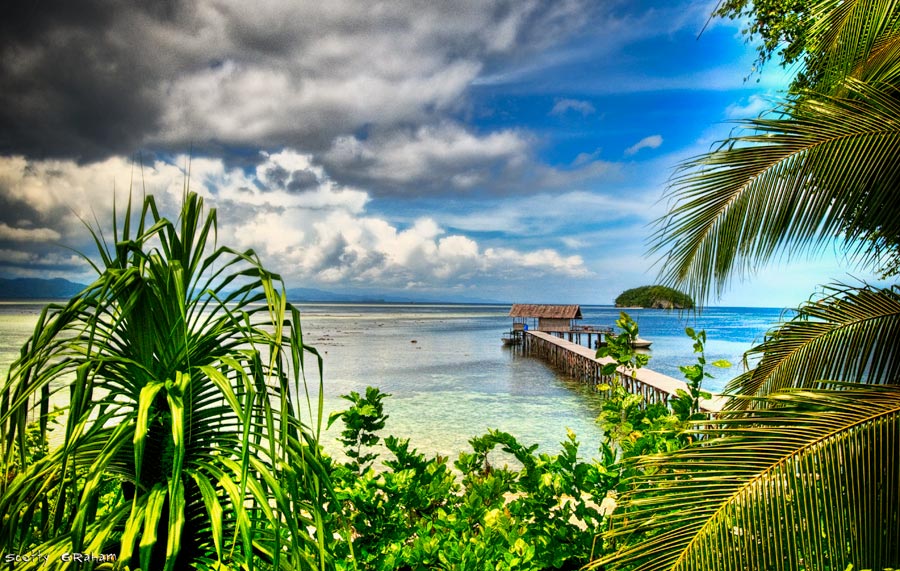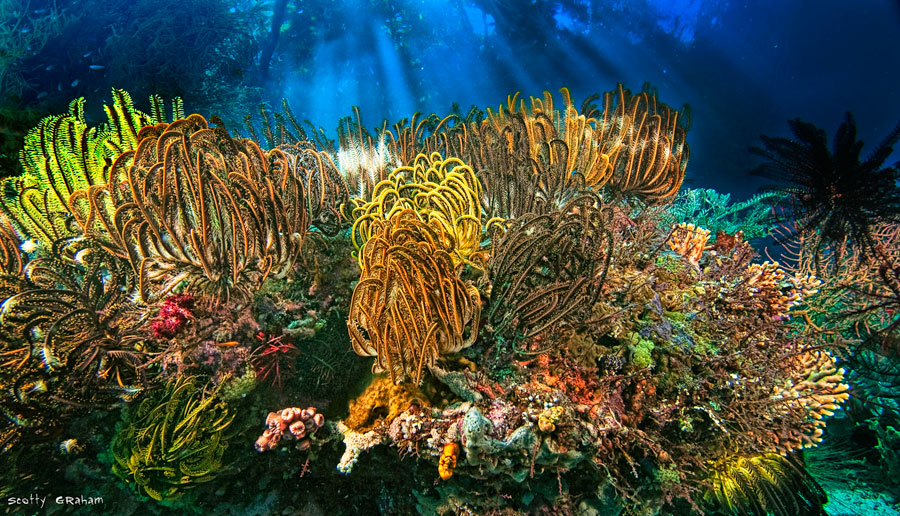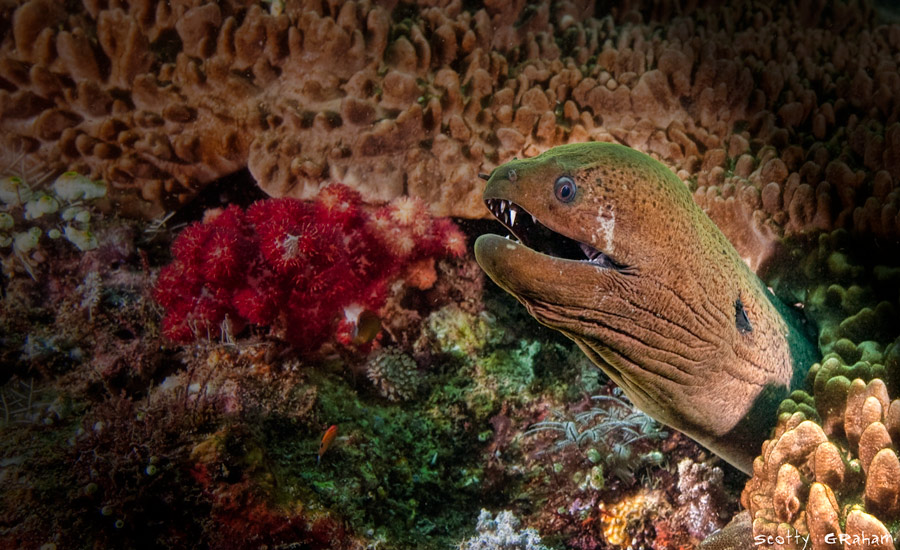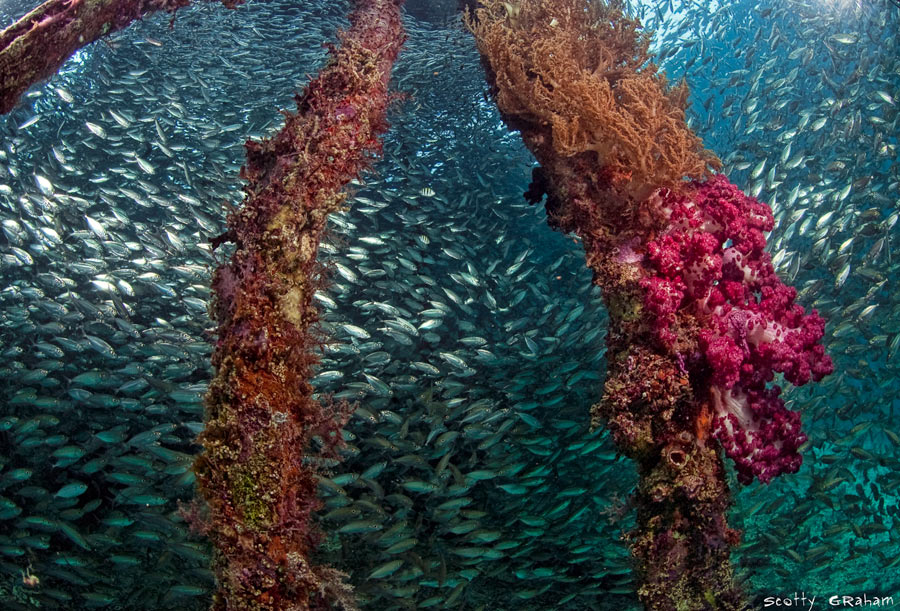
Raja Ampat diving is one of the best underwater exploration any scuba diver can testify to. Here is a pick of the best dive sites around Kri Island, and a bit beyond. Daily trips (except Saturdays) are made possible by Papua Diving where you can stay at Kri Eco Resort or Sorido Bay Resort – both located on Kri Island itself.
SARDINE REEF
Sardine reef is quite simply one of the best reef dives in the world, where divers witness the phenomenal diversity of Raja Ampat at full force. Where the current strikes this offshore reef and splits, a dazzling array of fish congregate, audibly swarming fusiliers spin above, pursued by huge giant trevelly , packs of bluefin jacks and huge Spanish mackerel. Batfish gather in the hundreds, while multitudes of schooling bannerfish feed in the current. Grey reef sharks, blacktips and whitetips can also be seen along with the wobbegong waiting in ambush on the sea floor. Coral bommies dot the slope covered with many colourful species of dendronephya soft corals and up to three separate species of pygmy seahorse can be found amongst them. On the current-swept reef top a resident school of thirty massive bumphead parrotfish crunch on the coral, keeping the divers company on a safety stop, who hang from their reef-hooks like kites in the wind. Upon surfacing, many divers comment that this is the best dive they have ever done!! Photographers love this dive site and have to return to change from wide angle to macro!

CAPE KRI
“On my last trip with Papua Diving I recorded 283 fish species during a single dive near the Kri Island resorts. This is the most fishes ever seen on single dive over a career spanning almost 30 years.” Dr Gerald Allen, author of 25+ marine life books
The world-record holding Cape Kri is just 3 minutes from our jetty. At the Northeast point of Kri island the currents sweep into a channel between Kri and the small island of Koh. At this point beneath waters churning in the current, huge schools of big-eye trevelly, barracudas and snappers can be seen hanging over the drop off. At the base of the reef at 38 meters an ancient snagged anchor rests next to a bommie with a dense school of banded sweetlips. A large shallow coral garden crowns the reef top with blacktip reef sharks patrolling amongst the overlapping maze of hard corals with feeding hawksbill turtles. Car-sized Queensland groupers down to the diminutive ever-present pygmy seahorse can be seen on this phenomenal and always-surprising dive site! Dawn and dusk are feeding time so divers can experience this site at its awe-inspiring best.
 |
| Crinoids |
MIKE’S POINT
The small innocuous looking rock island jutting from the sea belies the sheer mind-blowing topographical complexity below water. Named after Max Ammer’s son, Mike’s point is diving at its very best. Mistaken for a camouflaged Japanese ship this island was bombed during WW2, as from above the current flowing past the island was mistaken for a wake from a boat! The blast-fractured chunks of the island now lie below water in the most unearthly coral gardens on the planet. An overhanging wall drops from these sloping gardens to a protected bowl at 30 meters where schools of up to 250 sweetlips; Harlequins, Ribbonned and Lined sweetlips gather together. Here the tiny Denise pygmy also can be found, so yes... photographers need both wide angle and macro on this dive! At the end of the dive a clown fish city wafts in the current, where over 60 tomato anemone fish stake their territory in a 9 sq meter anemone field. Immense acropora beds almost touch the surface and the newly discovered black pontohi pygmy can also be found in the shallows. This dive site has been described as the best in the world...

THE PASSAGE
As seen in many articles, including recently by David Doubilet in the Sept 2007 National Geographic, the passage is completely unique dive site. The narrow canyon 40 minutes away between Gam and Waigeo can be described as river flowing between the two Islands, but also a marine environment, a haven of peculiar and unique microhabitats, where rare archer fish can be sighted and overhanging trees meet sea fans. Described by Andrea Ferrari in Wetpixel 2007:
“A five meter deep, river-like sea fjord, snaking inside the forest, the tree canopies often closing above it, strange purple sponges and gigantic orange sea fans almost reaching over the surface, the sea and sky mirroring each other. A mystical place, rich in silent grottoes, underwater passages, submerged tunnels leading to still underwater pools hidden inside the forest, sun rays slanting down in the green darkness, like light shining through a cathedral’s multicoloured widows...Yes this is heaven for me. Welcome to the Passage. Welcome to Raja Ampat.”
This is a place where experienced divers and photographers enjoy the utterly different experience of diving in this truly one-of-kind location. Above water the sheer limestone cliffs make this a place where the sightseeing above water is also excessively beautiful. Guests combine this trip visiting the labyrinthine Hidden Bay, a maze of towering islets, and Kabui Bay where literally hundreds of mushroom islands create staggering scenery.

MELISSA’S GARDEN
Part of the Fam Island group, one hour away, Melissa’s garden is named after Max Ammer’s daughter when he was the first to pioneer diving in this area. Three small islets poke from the sea, sitting on a shallow coral garden on the edge of a reef slope down to depth. Kaleidoscopes of multi-coloured anthaises swarm in their thousands in the shallows around these islets. Unblemished coral gardens of hard and soft corals embed every surface of the shallows. Ancient giant clams, now rare elsewhere in the world, sit filtering plankton, their colourful mantles absorbing energy from the bright sunlight of the gardens. The Fam Islands are the very definition of paradise. White limestone cliffs plunge into the sea, ultramarine blue lagoons nestled next to monumental towers and pinnacles, untouched beaches...there are many places that claim to be this beautiful, this is the genuine article.

BLUEWATER MANGROVES
Just 10 minutes away lies a mangrove system of clear mirror-still blue water, where corals grow in the shallow waters juxtaposed with arching roots of mangrove trees. Rising above the foliage of the mangroves high hardwood forests make a backdrop through which hornbills and parrots swoop between the trees. Upon entering from the sea the mangroves open into a complex interconnected network of channels and huge lakes, looking down into the water seagrasses sway in the current lying next to corals normally only seen on outer reefs. Amongst the mangrove roots juvenile fishes find a safe nursery, juvenile bumphead parrotfish, butterflyfish, archerfish and many others find refuge here, even dugong have been seen here! Diving inside the deeper lakes crab-eyed gobies can be found, and snorkelling through the many hidden channels guests enter secluded groves where fallen trees, mangrove roots and shallow coral gardens are found in this genuinely unique habitat.
MANTA POINT
If the many reefs are not enough this area also boasts some of the best manta diving in the world! Nowhere else can offer reefs of such diversity along with a year round possibility of manta diving. There are two main manta sites just half an hour away. One, Manta Sandy, is a cleaning station where up to 10 mantas can be seen vying for a position above the two rocks where wrasses clean these giants. We get enormous 4 meter wide black mantas, looking like a negative photographic image, their gills are highlighted in white, along with the other more common white-bellied variety. Another site nearby, Manta Slope, mantas circle above in the sun while divers hook onto the reef while the current arcs overhead and down the steep slope below. Divers can be caught unaware while giant demonic-looking black mantas cruise by behind them.

LALOSI
Near to the manta spots is a long thin submerged offshore reef which Max Ammer describes as having the best corals he has seen in Raja Ampat. Mature fully-grown specimens of every hard coral imaginable crest the reef, a coral specialists paradise, acropora forms every imaginable configuration. Thousands of fish rise from the reef feeding in the currents, and large 1.5 meter long banded sea snakes can be spotted hunting in the shallows. On the slopes on either sides tiny squat lobsters live on huge barrel sponges and cuttlefish merge into their surroundings. Fully mature Napoleon wrasses are found commonly here and throughout Raja Ampat, rare now elsewhere due to live grouper trade decimating populations. All populations of fishes are at their correct proportions, though shark numbers have been reduced due to finning, they are now returning due to the efforts of Conservation International and the new Marine Park status.
MIOS KON
10 minutes out an island populated by thousands of flying foxes protects a shallow sloping reef named Mios Kon. Here hundreds of bluelined snapper school close to the shallow reef, large gorgonian draped bommies rise and wobbegong sharks lie in wait below for hapless fish to swim past their nose. Leaffish can be found at the secluded foot of the bommies and an ancient 1 meter+ gaint clam sits, almost a mini-reef in itself, soft corals cling to its shell, and scorpion fish in turn using them for cover. Flawless overlapping plate corals grow on the reef top where the newly discovered black pontohi pygmy seahorse can be found. Mios Kon is great dive site to escape from the exposed currents.

CHICKEN REEF
5 minutes out is a large triangular offshore reef, comprising three main sites: Sleeping Barracuda, Surgeonfish Slope and Chicken reef. Chicken reef is named after a diver was seen cowering behind a bommie from a small blacktip reef shark! Pygmies can be found here including the rare yellow bagibanti, along with huge schools of unicorn surgeonfish and large predatory fish swarming where the current hits the reef dead on. A yellow clown frogfish can sometimes be seen sitting comically with a white and red clown frogfish at its side and three leafish sitting nearby. Blacktip reef sharks are making a comeback and the guides will try to lure them over by using plastic to bottles to mimic the sound of fleeing prey schools. When divers pass around the corner the main reef the currents reduce so divers can spend more time looking for smaller critters, such as nudibranchs and mantis shrimps.
Photography by Scotty Graham. Text resource: Papua Diving.
Read Gaia Discovery's interview with Max Ammer – pioneering dive operator, proprietor of Papua Diving and conservationist of Kri Island.
More information on Kri Eco Resort, Sorido Bay Resort and Papua Diving at:
http://www.papua-diving.com
Sorong Office:
PT Papua Diving
Jalan Gunung Tidar No.1
Kampung Baru Sorong
PAPUA - 98413 Indonesia
Phone: +62 (951) 328 038
Fax: +62 (951) 328 038
info@papua-diving.com
Contact Max at max@papua-diving.com
Getting there:
It is easiest to fly through to Sorong via Jakarta or via Singapore. Merpati, Express Air and Lion Wings operate daily flights from Jakarta to Sorong (with stopovers in Ujung Pandang/Makassar and/or Manado), whereas Silk Air operates regularly from Singapore to Manado. Regular flights to and from Sorong by Airlines Merpati and Lion Wings. Check directly with Papua Diving for current schedule or click on flightschedule for latest flight information.
About SilkAir
Singapore-based SilkAir flies one of the youngest fleets in the Asia region, with an average age of 5.5 years. It operates fifteen aircraft, nine Airbus A320-200 and six Airbus A319-100 aircraft. SilkAir positions itself as a premium, short-to-medium haul regional carrier offering unique appeal amongst leisure and business travelers in Asia. Visit www.silkair.com for more information.
In conjunction with its 20th anniversary celebrations, SilkAir recently announced the adoption of Friends-International, an award-winning Non-Governmental Organization (NGO) which focuses on reducing the number of street children across Asia and beyond, as its official charity. Sharing Friends-International’s vision to give children access to education, SilkAir will offer two children from the NGO’s vibrant Phnom Penh headquarters SilkAir Scholarships to study English at the Australian Centre for Education in the Cambodian capital.
